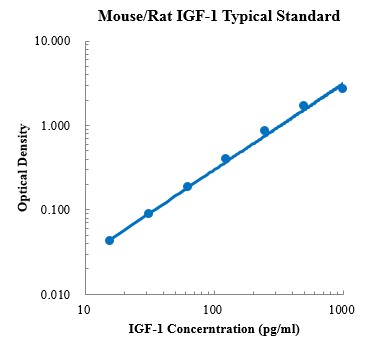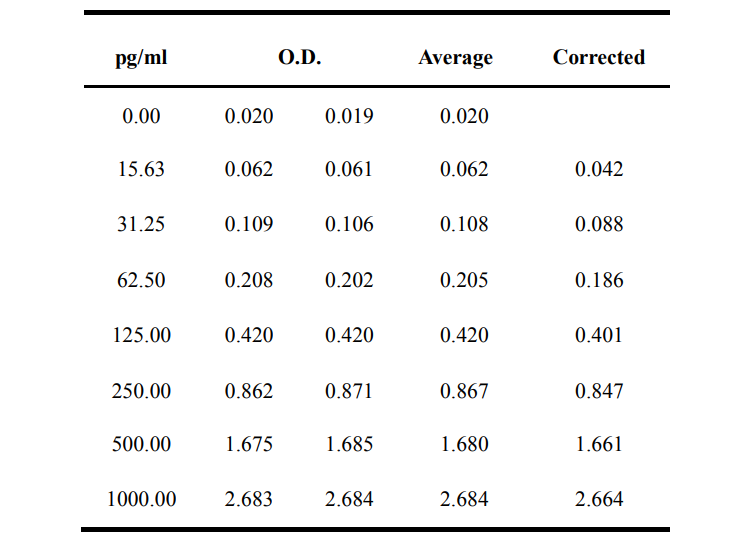
Mouse/Rat IGF-1 ELISA Kit
$350.00 – $450.00
| Sample Type | Serum, plasma, cell culture supernatant, and other biological samples |
|---|---|
| Sample Volume | 100 μL |
| Sensitivity | 0.82 pg/mL |
| Range | 15.63 pg/mL – 1000 pg/mL |
| Assay Time | 3.5 h |
| Recovery | 95% – 110% |
| Average Recovery | 1.02 |
| Intra Precision | 2.9% – 3.6% |
| Inter-Precision | 2.0% – 4.1% |
| Platform | ELISA |
| Plate | Detachable 96-well plate |
| Size | 96T/48T |
| Storage | If the reagent kit is unopened, it should be stored at 4℃. However, if it has been opened, the standard solution should be stored at -20℃, while the other components should be stored at 4℃. |
| Delivery | 4℃ blue ice transportation |
| Components | 96-well polystyrene enzyme-linked immunosorbent assay (ELISA) plate coated with anti-IGF-1 monoclonal antibody Mouse /Rat IGF-1 freeze-dried standard IGF-1 detect Antibody Standard Diluent Assay Buffer(10×) Substrate TMB Stop Solution Washing Buffer(20×) Sealing Film |
| Assay Principle | This kit utilizes the double antibody sandwich enzyme-linked immunosorbent assay (ELISA) detection technique.Specific anti-mouse /rat IGF-1 antibodies are precoated on a high-affinity ELISA plate.Standards and test samples are added to the wells of the ELISA plate. After incubation, the IGF-1 present in the samples binds to the solid-phase antibodies. After washing to remove unbound substances, biotinylated detection antibodies are added and incubated. After washing to remove unbound biotinylated antibodies, streptavidin-HRP labeled with horseradish peroxidase is added. After washing, a colorimetric substrate, TMB, is added and the plate is incubated in the dark for color development. The intensity of the color reaction is directly proportional to the concentration of IGF-1 in the samples. A stop solution is added to terminate the reaction, and the absorbance value is measured at a wavelength of 450 nm (with a reference wavelength range of 570-630 nm). |
Targets
IGF1
IGF1 Target Infomation Overview
- Target Symbol: IGF1, insulin like growth factor 1
- Gene Groups: Neuropeptides
- Alias: IGF1A; IGFI; IGF-I; IGF
- Alias Names: somatomedin C; insulin-like growth factor 1 (somatomedin C)
IGF1, insulin like growth factor 1 Target Infomation by Species
[su_tabs][su_tab title=”Human” disabled=”no” anchor=”” url=”” target=”blank” class=”tab-human”]
Human IGF1 Target Information
- Target Symbol: IGF1, insulin like growth factor 1
- Alias:
- IGF
- IGF-I
- IGF-IA
- IGF-IB
- IGF1A
- IGFI
- insulin-like growth factor 1
- insulin-like growth factor 1 (somatomedin C)
- insulin-like growth factor I
- insulin-like growth factor IA
- insulin-like growth factor IB
- mechano growth factor
- MGF
- somatomedin-C
- NCBI_Gene: 3479
- UniProtKB: P05019
Human IGF1 Predicted Functions
Enables signaling receptor binding activity. Involved in several processes, including positive regulation of cell population proliferation; positive regulation of macromolecule metabolic process; and positive regulation of signal transduction. Acts upstream of or within cell activation. Located in extracellular space. Part of alphav-beta3 integrin-IGF-1-IGF1R complex and insulin-like growth factor ternary complex. Implicated in several diseases, including acne; brain ischemia; diabetes mellitus (multiple); myopia; and neurodegenerative disease (multiple). Biomarker of several diseases, including Henoch-Schoenlein purpura; artery disease (multiple); autoimmune disease (multiple); bone disease (multiple); and eye disease (multiple).
[/su_tab]
[su_tab title=”Mouse” disabled=”no” anchor=”” url=”” target=”blank” class=”tab-mouse”]
Mouse Igf1 Target Information
- Target Symbol: Igf1, insulin-like growth factor 1
- Alias:
- C730016P09Rik
- Igf-1
- Igf-I
- RIKEN cDNA C730016P09 gene
- NCBI_Gene: 16000
Mouse Igf1 Predicted Functions
Enables insulin receptor binding activity and insulin-like growth factor receptor binding activity. Involved in negative regulation of gene expression; negative regulation of release of cytochrome c from mitochondria; and positive regulation of myelination. Acts upstream of or within several processes, including animal organ development; positive regulation of cell population proliferation; and regulation of signal transduction. Located in exocytic vesicle and extracellular space. Is expressed in several structures, including alimentary system; central nervous system; genitourinary system; limb; and sensory organ. Human ortholog(s) of this gene implicated in several diseases, including acne; artery disease (multiple); diabetes mellitus (multiple); myopia; and neurodegenerative disease (multiple). Orthologous to human IGF1 (insulin like growth factor 1).
[/su_tab]
[su_tab title=”Rat” disabled=”no” anchor=”” url=”” target=”blank” class=”tab-rat”]
Rat Igf1 Target Information
- Target Symbol: Igf1, insulin-like growth factor 1
- Alias:
- IGF
- IGF-I
- insulin-like growth factor I
- somatomedin
- NCBI_Gene: 24482
Rat Igf1 Predicted Functions
Enables protein serine/threonine kinase activator activity; signaling receptor binding activity; and steroid binding activity. Involved in several processes, including cellular response to hormone stimulus; negative regulation of cell death; and positive regulation of cell differentiation. Located in several cellular components, including interstitial matrix; neuronal cell body; and platelet alpha granule. Used to study brain ischemia; diabetic neuropathy; and hypertension. Biomarker of several diseases, including alcoholic neuropathy; artery disease (multiple); congenital diaphragmatic hernia; folic acid deficiency anemia; and hypothyroidism (multiple). Human ortholog(s) of this gene implicated in several diseases, including acne; brain ischemia; diabetes mellitus (multiple); myopia; and neurodegenerative disease (multiple). Orthologous to human IGF1 (insulin like growth factor 1).
[/su_tab][/su_tabs]
IGF1 Target News
[catlist tags=”igf1″ template=targetnews thumbnail=yes thumbnail_class=”related-post-media clr” thumbnail_size=833]





